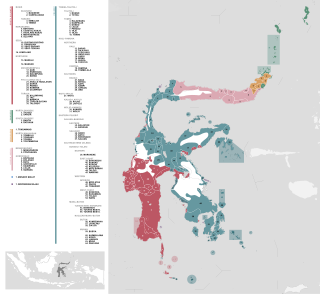
Tanacross is an endangered Athabaskan language spoken by fewer than 60 people in eastern Interior Alaska.
The Ata language, also known as Pele-Ata after its two dialects, or Wasi, is a Papuan language spoken on New Britain island, Papua New Guinea. It appears to be related to neighboring Anêm, and possibly also to Yélî Dnye in a proposed Yele-West New Britain family. There are about 2000 speakers.
Moronene is an Austronesian language spoken in Bombana Regency, Southeast Sulawesi, Indonesia. It belongs to the Bungku–Tolaki branch of the Celebic subgroup.

The Bungku–Tolaki languages are a group of languages spoken primarily in South East Sulawesi province, Indonesia, and in neighboring parts of Central and South Sulawesi provinces.

The Celebic languages are a subgroup of the Austronesian languages spoken on the Indonesian island of Sulawesi, formerly called Celebes. Almost all of the languages spoken in the provinces of Central Sulawesi and Southeast Sulawesi belong to the Celebic group. A few Celebic languages are located in South Sulawesi province. By number of languages, Celebic is the largest subgroup of Austronesian languages on Sulawesi.

On the Indonesian island of Sulawesi, 114 native languages are spoken, all of which belong to the Malayo-Polynesian subgroup of the Austronesian language family. With a total number of 17,200,000 inhabitants, Sulawesi displays a high linguistic diversity when compared with the most densely populated Indonesian island Java, which hosts 4–8 languages spoken by 145,100,000 inhabitants.
Tolaki (To'olaki) is the major language of Southeast Sulawesi, Indonesia. It is an Austronesian language of the Celebic branch.
In its broad sense, Mori is a cover term used to refer collectively to two languages of Central Sulawesi: Mori Bawah and Mori Atas. Sometimes a third language, Padoe, is also included.
Kulisusu is an Austronesian language of Southeast Sulawesi, Indonesia. It is part of a dialect chain with two minor languages, Koroni and Taloki.
Wawonii (Wowoni) is an Austronesian language of the Wawonii and Menui islands of Indonesia. The language is quite close to the Bungku language.
Bungku is an Austronesian language of Southeast Sulawesi, Indonesia. It is quite close to Wawonii. It was a local lingua franca before independence.
Mori Bawah, also known as Lower Mori or East Mori, is an Austronesian language of the Celebic branch. It is one of the principal languages of the Morowali Regency in Central Sulawesi.
Padoe is an Austronesian language of the Celebic branch. It was traditionally spoken in the rolling plains south of Lake Matano in South Sulawesi province. In the 1950s, a portion of the Padoe-speaking population fled to Central Sulawesi to escape the ravages of the Darul Islam / Tentara Islam Indonesia (DI/TII) revolt. In 1991, it was estimated there were 5,000 speakers of Padoe in all locations.
Bahonsuai is an Austronesian language of Central Sulawesi, Indonesia.
Tomadino is an Austronesian language of Central Sulawesi, Indonesia. It belongs to the Bungku–Tolaki branch of the Celebic subgroup.
Waru is an Austronesian language of Southeast Sulawesi, Indonesia.
Kodeoha (Kondeha) is an Austronesian language of Southeast Sulawesi, Indonesia.
Rahambuu is an Austronesian language of Southeast Sulawesi, Indonesia.
The Proto-Philippine language is a reconstructed ancestral proto-language of the Philippine languages, a proposed subgroup of the Austronesian languages which includes all languages within the Philippines as well as those within the northern portions of Sulawesi in Indonesia. Proto-Philippine is not directly attested to in any written work, but linguistic reconstruction by the comparative method has found regular similarities among languages that cannot be explained by coincidence or word-borrowing.

Bungku people are an ethnic group who mostly resides in North Bungku, South Bungku, Central Bungku, and Menui Islands districts di Morowali Regency, in Central Sulawesi province of Indonesia. This ethnic group is divided into several sub-groups, namely Lambatu, Epe, Ro'tua, Reta, and Wowoni. Bungku people have their own language, called Bungku language, which is one of their characteristic and serves as a means of communication between themselves. They generally embrace Islam or Christianity.